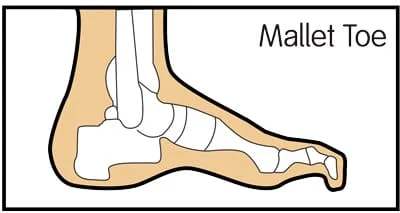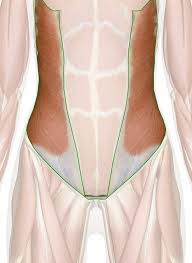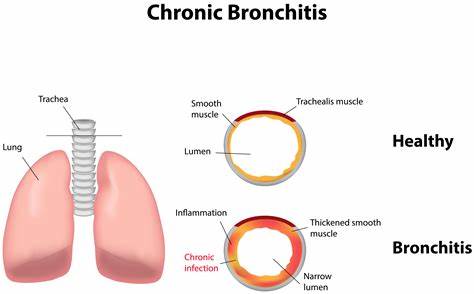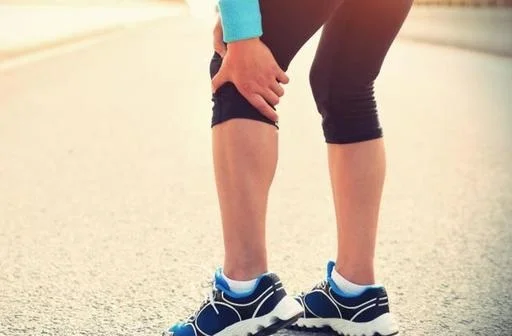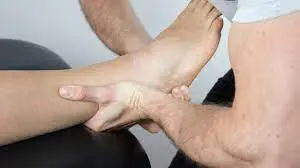MALLET TOE : PHYSIOTHERAPY TREATMENT
Table of Contents
Introduction:
- Mallet toe is a painful flexion deformity of the distal IP joint. The second toe is affected most commonly, although the deformity may occur in all toes. Mallet toe is usually the result of a jamming injury to the toe. However, as with bunion and hammer toe, the wearing of tight, narrow-toed shoes has also been implicated; also like bunion, mallet toe occurs more commonly in female patients than in male patients. An inflamed adventitious bursa may accompany mallet toe and contribute to the patient’s pain. A callus or ulcer overlying the tip of the affected toe may be present as well. Wearing high-heeled shoes may exacerbate the problem.
Mallet toes are also classified into flexible or rigid mallet toe :
- Flexible mallet toes : The muscle and toe joint are still flexible and movable.
- Rigid mallet toes : The muscle and nearby tendons (tissues that attach muscle to bone) tighten. This change freezes the toe joint in a bent position.
How to Define mallet toes?
- A mallet toe is a deformity of the distal IP joint in the foot, which has abnormal flexion that is either fixed or flexible. It may also be accompanied by symptoms of pain or callosity. For most patients, the longest toe is affected, but it can also occur in the second, third or fourth toe joint.
Which are the Causes of Mallet toes ?
In most cases the cause of mallet toe is not known, referred to as idiopathic. There are various factors that have been associated with an increased risk of mallet toe, however, including:
- Congenital abnormalities
- Trauma
- Neuromuscular disorders
- Pes cavus
- All of these potential causes place additional pressure on the tip of the toe or attenuate the extensor tendon in the toe. As a result, calluses or deformity of the nail can also affect the tip of the toe.
- Arthritis.
- Bone and muscle imbalances, such as foot bones that are too short or muscles that are especially weak.
- Injury to the toe.
- Shoes that are too tight.
Which Symptoms commonly seen in Mallet toe ?
- Redness and swelling of the affected toe.
- Corns or calluses on the bent part of the toe.
- Toe pain when wearing shoes or walking.
- Toe sores or ulcers, especially in people with diabetes.
- Toenail thickening or changes.
Risk Factors :
- a family history of mallet toe.
- chronically wearing tight or pointy-toed shoes.
- having calluses, bunions, or corns, which are thickened layers of skin caused by prolonged and repeated friction.
- Age. The risk of hammertoe and mallet toe increases with age.
- Sex. Women are much more likely to develop hammertoe or mallet toe than are men.
- Toe length. If your second toe is longer than your big toe, it’s at higher risk of hammertoe or mallet toe.
- Certain diseases. Arthritis and diabetes might make you more prone to developing foot deformities. Heredity might also play a role.
How to Diffentiate mallet toes, hammer toes and clawtoes ?
Although all three conditions affect joints in the toes, they have important differences:
- Mallet toes : Bend in the third toe joint, closest to the toenail.
- Hammer toes : Bend in the second, or middle, toe joint.
- Claw toes : Bend in the first toe joint, and possibly the second and third joints.
Differential Diagnosis:
- Claw Toe
- Clavus
- Hallux valgus
- Gout
- Osteochondrotic lesion of the first metatarsal head
- Sesamoiditis; turf toe
- Osteochondritis
- Metatarsal stress fracture
- Metatarsalgia
How Diagnosis done in Mallet toe ?
- Mallet toes should get diagnosed by a healthcare provider. You can start with your primary care physician (PCP) or visit a podiatrist (foot and ankle doctor). Mallet toes usually just need a thorough physical exam. Your provider will:
- Look at your footwear.
- Likely check the toe’s flexibility.
- Possibly do a gait analysis, to assess the way you walk.
- Take an X-ray of your foot.
- Perform a foot and ankle exam.
- Debride (remove) any painful skin or nail.
- The physical exam can help determine if you’re putting added pressure or stress on the affected toe. In some cases, your healthcare provider may also order imaging tests. An X-ray will rule out any toe fractures (broken bones).
Physiotherapy Treatment:
The Toe Stretch:
- Stretching your toe helps to make the joint more flexible, which can help relieve the symptoms of the condition and make mallet toe easier to live with.
- Gently hold the affected toe in your dominant hand
- Stretch the toe in the opposite direction to which it is bent
- Do this one joint at a time until you can feel a slow, gentle pull
Do this several times in the morning and several times at night, or however often your therapist recommends.
The Towel Exercise:
- This exercise helps increase the strength of the affected toe, as well as stretching it. This helps to work the mallet toe and make it more flexible. It’s also incredibly easy to do.
- Place a towel flat on the floor
- Using all the toes of the affected foot, crumple the towel up
Repeat as many times as directed by a therapist.
The Marble Exercise:
- This is very similar to the towel exercise, except it uses marbles and requires more dexterity and control of your toes, which makes it great for improving the flexibility of your affected toe.
- Place one or more marbles on the floor
- Using the toes of your affected foot, pick them up
Repeat as many times as directed by a therapist.
Medical Treatment:
Mallet toe treatment can take many forms. Fortunately, most people find relief with conservative treatments. That means they don’t need surgery. If the mallet toe is still flexible, your healthcare provider may recommend:
- Gently exfoliating, or smoothing, calluses.
- Putting toe pads on corns or calluses.
- Reducing inflammation with a steroid injection.
- Stretching your toes frequently.
- Using orthotics (special shoe inserts) to take pressure off the affected toe.
- Wearing shoes with extra room in the toes.
For people with diabetes, proper foot care is essential. Tips for foot health include:
- Checking your feet for sores or injuries each day.
Keeping your feet clean and dry.
Trimming your toenails regular - Never try to cut off corns or calluses yourself. Always allow a healthcare provider to assess diabetic foot issues. The provider will recommend the best treatment.
Surgical Treatment:
Percutaneous/open FDL tenotomy
- indications
- flexible deformities that have failed nonoperative management
- FDL transfer to dorsum of phalanx
- _indications
- to prevent unopposed extensor with FDL tenotomy and cock-up deformity
- DIPJ fusion or middle phalangeal distal condylectomy (excisional arthroplasty of DIP)
- _indications
- rigid deformities that have failed nonoperative management
- technique
- repair attenuated extensor tendons
- K wire placement used to hold affected digit in extension
Arthroplasty: Removing part of the bent toe bone and realigning it.
Tendon release: Cutting a tight toe tendon to allow the toe to lay flat.
Tendon transfer: Moving the tendon in the mallet toe to another part of the foot, to force the toe to straighten.Avoid shoes that pinch or crowd your toes.
How can I prevent mallet toe? (Preventive Measure) :
- Avoid shoes that pinch or crowd your toes.
- Choose footwear with a low heel to take pressure off your toes.
- Stretch your feet and toes regularly.
- Have your shoes sized by a sales professional.

